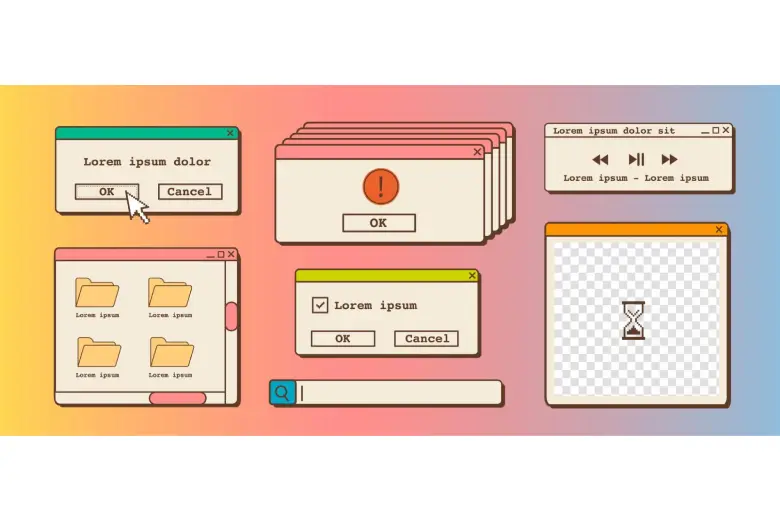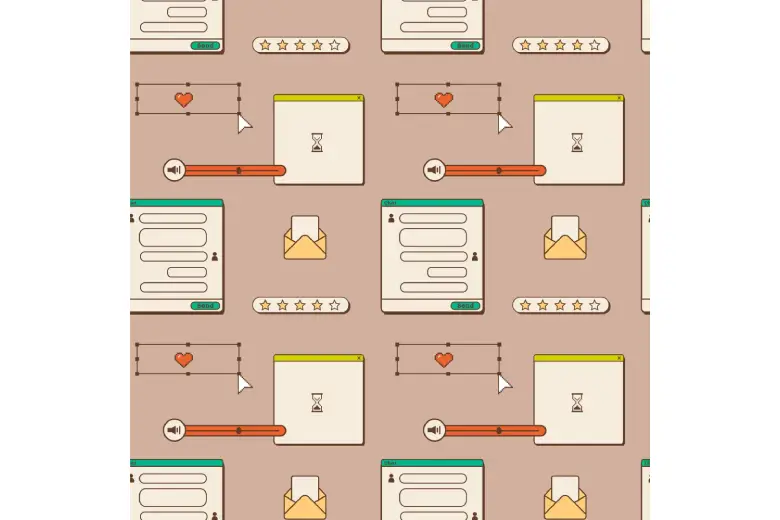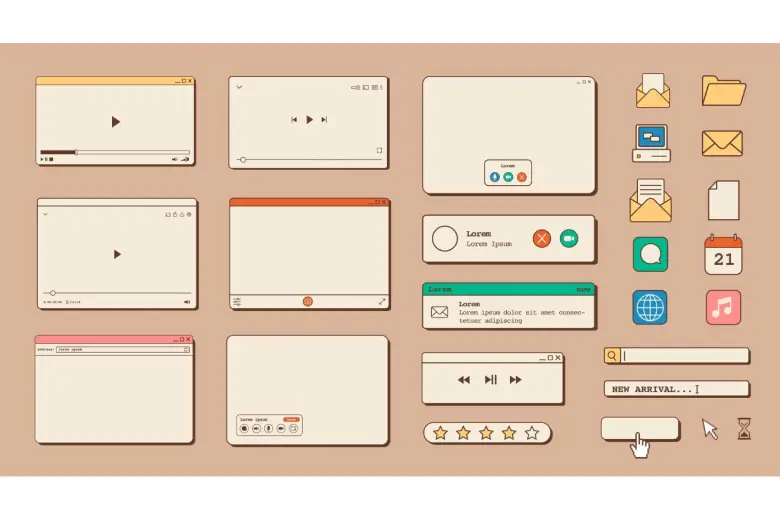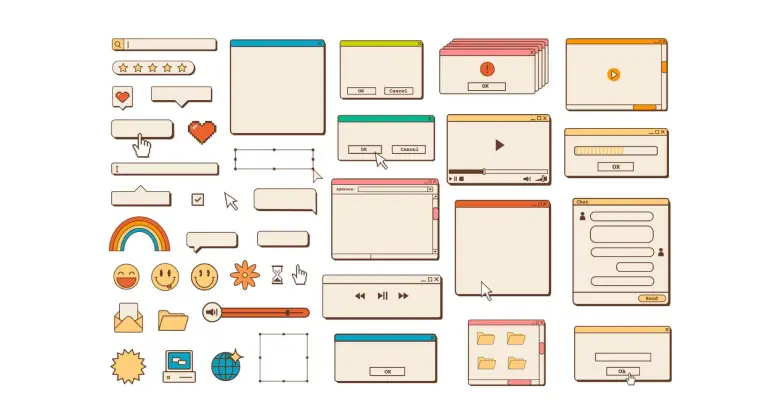Your complete guide to design systems, including their creation, benefits, best practices, and application in UI design
A design system is the foundation for consistent, efficient, collaborative, and user-centric designs that bring about intuitive and seamless user experiences. It’s a unified set of guidelines, principles, and interface components that ensures the delivery of a digital product fully aligned with the goals of the business and the user.
As brands increasingly recognise the importance of positive user experiences in attracting and retaining customers, the interest and investment in the processes that create this experience have also grown. Whether designing for multiple platforms or scaling a product, a design system is essential to maintaining a cohesive and effective design process.
But if you’ve not used a design system before, where do you start? In this guide, we equip you with the knowledge you need to work with a design system, understand its role in the design process, and even create your own.
Contents:
- What is a design system?
- What’s the difference between a design system and a style guide?
- When to use a design system
- How to create a design system – key elements
- What are the benefits of using a design system?
- Best practices for creating a design system
- Conclusion
Ready to learn more? Let’s dive into the details.
What is a design system?
A design system is the name given to the rules, standards, principles, documentation, and reusable components that inform and guide the design of digital products. This detailed library of resources provides all team members with a central reference point of actionable instructions and guidelines, ensuring a cohesive and consistent approach to the design process.
A design system supports the design teams by:
- Streamlining workflows
- Ensuring consistency across a product or products
- Supporting effective communication
- Fostering collaboration across different teams
- Making it easier to scale a project
- Aligning stakeholders with a single point of reference
- Accelerating the development process
- Saving teams’ time
- Facilitating the creation of a cohesive user experience
What’s the difference between a design system and a style guide?
The terms “design system” and “style guide” are sometimes confused due to the similar roles they play in the design process. However, while both operate as design reference guides, they fulfill different functions for the team. The design system is an overarching set of rules or standards that guides the entire design process. However, a style guide is merely a subset of the design system that is only concerned with the visual language of the product. To that end, the style guide comprises visual styles, including colors, typefaces, imagery, and negative space, that the team should use when designing the product or creating new visual elements. By using a style guide, designers can be sure that the product has a uniform and consistent visual identity that can be seamlessly scaled.

When to use a design system
A design system isn’t necessary for every project a design team works on. However, there are instances where a design system isn’t only helpful but essential to a project’s success. If you’re not sure when to use a design system, read on.
Here’s a run-through of when it’s critical to have a robust design system in place to enable consistency, alignment, and scalability.
1. Working on large-scale projects
Consistency in design is a key component of successful digital products, as a consistent user experience builds trust and familiarity with users, mitigates confusion or errors, and helps users reach their goals faster.
On large-scale projects in particular, a design system is an invaluable resource for ensuring a consistent user experience. It provides a common reference point that aligns teams and standardizes design patterns, components, as well as workflows. By leveraging a design system, designers, developers, and stakeholders working on different aspects of the product can mitigate the risk of inconsistencies and work more collaboratively.
2. Designing for multiple platforms or devices
These days, digital products are expected to deliver the same high-quality experience for users across multiple devices and platforms. With each platform often having its unique constraints and requirements, not to mention user expectations, a design system supports designers in addressing these challenges by providing unified design elements, patterns, and responsive design principles. This robust structure and approach ensures that the design can be adapted more easily to different platforms or devices without compromising the user experience.
3. Scaling a product
When a product or project grows in size, it’s not uncommon for complications and considerations related to its design and development to arise. For companies looking to scale a product, a design system is ideal. By providing reusable design components, clear guidelines, and pre-approved company-wide standards, a design system ensures all new additions and updates align with the established mission, goals, and values.
4. Onboarding new team members
Having a centralized guide containing company-wide design standards, principles, values, guidelines, and design components is an absolute game-changer when it comes to onboarding new team members. This library of information means they have a go-to reference point containing clean documentation and tangible examples to work from. With a design system, a new employee can transition into the design team much more quickly. But there’s more: thanks to the comprehensive nature of a well-crafted design system, new designers gain confidence to make design decisions sooner, too.
5. Working with external collaborators
Bringing freelancers, consultants, or contractors into a design project can feel like a risky business. Not only do the in-house design team need to communicate effectively the goals, mission, and vision of a digital product, but they also need to clearly convey the desired visual language the team has decided upon–no easy task! This challenge is made harder due to the growing trend for tech professionals to work remotely rather than in-house.
With a design system, communication with external collaborators, whether in-person or remotely, is made significantly easier. The design team can share their preferred visual language, using examples, and communicate their process and approach through clearly described company-wide standards and guidelines. Thanks to the design system, external collaborators have a reference point and resources to work with, as well as detailed notes on the project’s history and how it has evolved. This documentation prevents mistakes from being repeated and deepens everyone’s understanding of why the design is the way it is.

How to create a design system and what its key elements are
What should you include in your design system? From an icon library to design tokens, we cover all of the key elements of this important design resource that you need to document in your design system.
1. Component library
A component library (also called a design library) is simply a collection of predetermined, prebuilt, reusable UI design elements, such as buttons, forms, navigation menus, and icons, that have a consistent visual identity aligning with the brand, project, or product. By housing all these components in a single location, a design team has a quick and easy-access reference point to learn about and implement specific UI elements.
A component library benefits in-house teams and external collaborators as it helps ensure those working on a project have the same visual reference point to work from and the resources they need to implement components in their designs. This results in products that have a consistent, cohesive, and professional appearance.
2. Pattern library
Sometimes confused with a component library, a pattern library is a collection of UI groupings or layouts, such as content structures and templates. In the same vein as a component library, the idea behind the pattern library is to give the design team solutions to frequently-occuring design problems. These patterns can be adapted or tweaked to meet the specific challenges of different design projects. A pattern library ensures that the look and feel of a design are the same across a digital product or project. It also saves time, as the design team does not have to invent a unique solution to every new problem. A pattern library also supports collaboration, with everyone working from the same visual reference points.
3. Design principles
The design principles in the design system are the design team’s founding guidelines. They outline the reason behind the design system and explain how it should be used by team members working on the project. For new team members, the design system’s principles also help them better understand the company’s vision, goals, and priorities.
When creating the design principles for your design system, try to:
- Define and communicate the key attributes of the product to those at different experience levels (clients, colleagues, designers, developers)
- Articulate the main goals that all design decisions for the project should be measured against
- Use inclusive and collaborative language and terminology
- Evaluate and update the principles over time in accordance with new information or needs
4. Brand values
The brand values are the core principles and beliefs that underpin the brand itself. Designers refer to them when taking action, making decisions, and interacting with users to ensure that products consistently reflect the brand’s identity, mission, and purpose. By placing the brand values in the design system documentation, the team can be confident that these beliefs shine through in the designed products, enabling them to design with integrity. When done authentically, the brand’s products and services establish stronger emotional connections with consumers.
Examples of brand values that you might find in the design system include:
- Sustainability
- Innovation
- Customer-centricity

5. Content guidelines
Usually created by in-house brand, marketing, and content specialists, these guidelines inform content creators how to use language that reflects the brand’s established personality. This might include guidance on the tone, style, grammar, terminology, and language of the textual content used in the digital product, such as on landing pages, in an app, or in communication with users. The benefit of establishing content guidelines that all teams can refer to is that it ensures that the team uses a uniform brand voice and consistent visual design. This is important for establishing trust, appearing professional, and crafting a consistent user experience.
6. Icon library
Not to be confused with the component library, the icon library contains a collection of the brand’s standardized visual symbols that communicate actions, objects, and ideas without the need for text. Designed to be simple, intuitive, and instantly familiar, icons enhance accessibility and usability, guiding users effortlessly through the interface. The icon library is hugely beneficial as it ensures consistency across an interface, creates a unified look across devices and platforms, and saves designers time as they can quickly find the relevant symbol in the library, removing the need to design a new icon from scratch each time.
7. Design tokens
Bridging design and development teams, design tokens are abstract representations of visual design decisions, stored as data instead of hardcoded values. These variables serve to store all style-related design decisions, such as colors, typography, and spacing, in a standardized, reusable format. Contributing to a unified, consistent, and efficient design process, design tokens make it easier for teams to scale projects at speed and be adaptable in their decision-making without compromising on coherence or consistency. They are also a highly effective communication tool between the design and development teams, simplifying the process of handing over a design to be programmed and ensuring it gets coded in the way the design team has intended.

What are the benefits of using a design system?
It streamlines workflows and enables cross-functional team alignment, but what are the other benefits of using a design system? We dive into all the reasons you need one for your next digital product design project.
1. Speeds up development
A thorough design system speeds up development in a number of ways.
- It provides reusable components that can be easily implemented, minimizing time spent on redesigns.
- It reduces decision-making time by guiding designers in how to act, moving the process along more quickly.
- New design team members, developers, and external collaborators can jump into a project more quickly, using the design system as a reliable reference.
2. Streamlines processes
A design system eliminates confusion with its consistent approach to visual design, promotes efficient workflows, and reduces decision-making fatigue thanks to its standardized practices, principles, and guidelines. This aligns team members and streamlines all internal processes. With fewer back-and-forths between the development and design teams when the design is being programmed, more predictable results in line with business and user goals follow.
3. Supports better alignment and collaboration
Design teams often have to work with a range of teams across a company, as well as external professionals, to create a digital product. A design system supports better alignment across different departments and enables more streamlined collaboration by ensuring everyone works from a unified reference. A design system gives everyone the same language, vision, principles, guidance, and tools, enabling smoother cross-team collaboration and fostering more cohesive design and development decisions over the course of the project.
4. Enables smoother scalability
By providing an existing framework that new features can be integrated into, a design system enables smoother scalability–a huge benefit for businesses looking to enhance, expand, and develop existing products. From reusable components to standardized design elements, a design system facilitates consistent, steady growth, even as new team members are brought on-board or product variations are required.
5. Promotes inclusive design practices
Prioritizing accessibility and inclusivity is paramount to creating a positive user experience for all users when interacting with a digital product. A mindfully-created design system can help to promote inclusive design practices; when accessibility guidelines and inclusive design principles are part of its documentation, it enables the creation of interfaces that those of all abilities and experiences can access. The standardization of such practices serves as a useful reminder to design teams to always put the user at the centre of every design and create products that nurture fairness and impartiality.

Best practices for creating a design system
We’ve compiled the top three best practices used by teams when creating design systems to guide you as you create yours.
1. Document everything clearly
Clear documentation is a must when creating an effective design system. Use inclusive language that those of different knowledge levels and experiences will understand and avoid using unnecessary jargon. Be sure to include comprehensive guidelines, detailed examples, reusable templates, and up-to-date resources to ensure that everyone working on the project has the information and references they need to contribute what’s needed of them.
2. Be open to adaptation
While it can be tempting to see a design system as a static resource, it’s actually much more valuable when viewed as a collection of resources and a living document. What this means is allowing for adjustments, tweaks, enhancements, clarifications, and improvements as the needs of the user and the business shift and evolve. You’ll need to consider potential developments in technology and design trends too and ensure your design system reflects these changes, remains relevant, and is set up to accommodate new ideas.
3. Encourage contributions from the design team
A design system should be a team effort. Why? Because by incorporating a range of voices, perspectives, and experiences, the system–as well as the products that result from it– becomes more robust, inclusive, and well-rounded. For the individuals working on the project, being encouraged to contribute to the design system also fosters a sense of ownership and collaboration. It helps team members feel listened to and reinforces the idea that their suggestions on how to work, design, and collaborate are valuable to the company. When team members contribute to the design system, they become much more invested in the entire process, are more likely to use the system effectively, and are happy to help improve it over time.
Conclusion
There you have it–a complete guide to design systems and their application in UI UX design. We hope, with this guide, you feel confident in crafting and applying a design system that conveys the principles and standards of your company and its designers, aligns with business and user goals, and strives for a seamless and intuitive user experience.
Next Steps
If you’d like to learn more about design, we’d recommend you head over to the AND Academy Design Blog for more articles like this one. You can also check out this project by AND Learner, Shantanu Pathak, to further gain insights into turning user needs into useful products. In case you think you need further assistance, here are some of our resources you can consider:
- Watch this session by Shiva Viswanathan, Design Head of Ogilvy Pennywise, and Naman Singh, Product Experience Designer at RED.
- Talk to a course advisor to discuss how you can transform your career with one of our courses.
- Pursue our UI UX Design courses – all courses are taught through live, interactive classes by industry experts, and some even offer a Job Guarantee.
- Take advantage of our scholarship and funding options to overcome any financial hurdle on the path of your career transformation.
Note: All information and/or data from external sources is believed to be accurate as of the date of publication.









